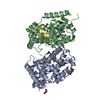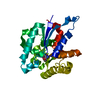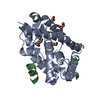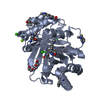Entry Database : PDB / ID : 3plzTitle Human LRH1 LBD bound to GR470 FTZ-F1 related protein Nuclear receptor coactivator 2 Keywords / / / / / / Function / homology Function Domain/homology Component
/ / / / / / / / / / / / / / / / / / / / / / / / / / / / / / / / / / / / / / / / / / / / / / / / / / / / / / / / / / / / / / / / / / / / / / / / / / / / / / / / / / / / / / / / / / / / / / / / / / / / / / / / / / / / / / / / / / / / / / / / / / / / / / / / / / / / / / / / / / / / / / / / / / / / / / / / / / / / / / / / Biological species Homo sapiens (human)Method / / / / Resolution : 1.75 Å Authors Williams, S.P. / Xu, R. / Zuercher, W.J. Journal : J.Med.Chem. / Year : 2011Title : Small Molecule Agonists of the Orphan Nuclear Receptors Steroidogenic Factor-1 (SF-1, NR5A1) and Liver Receptor Homologue-1 (LRH-1, NR5A2).Authors : Whitby, R.J. / Stec, J. / Blind, R.D. / Dixon, S. / Leesnitzer, L.M. / Orband-Miller, L.A. / Williams, S.P. / Willson, T.M. / Xu, R. / Zuercher, W.J. / Cai, F. / Ingraham, H.A. History Deposition Nov 15, 2010 Deposition site / Processing site Revision 1.0 Mar 30, 2011 Provider / Type Revision 1.1 Jul 13, 2011 Group Revision 1.2 Nov 8, 2017 Group / Category Revision 1.3 Feb 21, 2024 Group / Database references / Derived calculationsCategory chem_comp_atom / chem_comp_bond ... chem_comp_atom / chem_comp_bond / database_2 / struct_ref_seq_dif / struct_site Item _database_2.pdbx_DOI / _database_2.pdbx_database_accession ... _database_2.pdbx_DOI / _database_2.pdbx_database_accession / _struct_ref_seq_dif.details / _struct_site.pdbx_auth_asym_id / _struct_site.pdbx_auth_comp_id / _struct_site.pdbx_auth_seq_id
Show all Show less
 Open data
Open data Basic information
Basic information Components
Components Keywords
Keywords Function and homology information
Function and homology information Homo sapiens (human)
Homo sapiens (human) X-RAY DIFFRACTION /
X-RAY DIFFRACTION /  SYNCHROTRON /
SYNCHROTRON /  MOLECULAR REPLACEMENT /
MOLECULAR REPLACEMENT /  molecular replacement / Resolution: 1.75 Å
molecular replacement / Resolution: 1.75 Å  Authors
Authors Citation
Citation Journal: J.Med.Chem. / Year: 2011
Journal: J.Med.Chem. / Year: 2011 Structure visualization
Structure visualization Molmil
Molmil Jmol/JSmol
Jmol/JSmol Downloads & links
Downloads & links Download
Download 3plz.cif.gz
3plz.cif.gz PDBx/mmCIF format
PDBx/mmCIF format pdb3plz.ent.gz
pdb3plz.ent.gz PDB format
PDB format 3plz.json.gz
3plz.json.gz PDBx/mmJSON format
PDBx/mmJSON format Other downloads
Other downloads 3plz_validation.pdf.gz
3plz_validation.pdf.gz wwPDB validaton report
wwPDB validaton report 3plz_full_validation.pdf.gz
3plz_full_validation.pdf.gz 3plz_validation.xml.gz
3plz_validation.xml.gz 3plz_validation.cif.gz
3plz_validation.cif.gz https://data.pdbj.org/pub/pdb/validation_reports/pl/3plz
https://data.pdbj.org/pub/pdb/validation_reports/pl/3plz ftp://data.pdbj.org/pub/pdb/validation_reports/pl/3plz
ftp://data.pdbj.org/pub/pdb/validation_reports/pl/3plz Links
Links Assembly
Assembly


 Components
Components Homo sapiens (human) / Gene: NR5A2 / Plasmid: pLRH1_LBD / Production host:
Homo sapiens (human) / Gene: NR5A2 / Plasmid: pLRH1_LBD / Production host: 
 Homo sapiens (human) / References: UniProt: Q15596
Homo sapiens (human) / References: UniProt: Q15596 X-RAY DIFFRACTION / Number of used crystals: 1
X-RAY DIFFRACTION / Number of used crystals: 1  Sample preparation
Sample preparation SYNCHROTRON / Site:
SYNCHROTRON / Site:  APS
APS  / Beamline: 17-ID / Wavelength: 1 Å
/ Beamline: 17-ID / Wavelength: 1 Å molecular replacement
molecular replacement Processing
Processing MOLECULAR REPLACEMENT / Resolution: 1.75→19.94 Å / Cor.coef. Fo:Fc: 0.958 / Cor.coef. Fo:Fc free: 0.947 / Occupancy max: 1 / Occupancy min: 0.4 / SU B: 5.294 / SU ML: 0.076 / SU R Cruickshank DPI: 0.1231 / Isotropic thermal model: Isotropic / Cross valid method: THROUGHOUT / σ(F): 0 / ESU R Free: 0.113 / Stereochemistry target values: MAXIMUM LIKELIHOOD
MOLECULAR REPLACEMENT / Resolution: 1.75→19.94 Å / Cor.coef. Fo:Fc: 0.958 / Cor.coef. Fo:Fc free: 0.947 / Occupancy max: 1 / Occupancy min: 0.4 / SU B: 5.294 / SU ML: 0.076 / SU R Cruickshank DPI: 0.1231 / Isotropic thermal model: Isotropic / Cross valid method: THROUGHOUT / σ(F): 0 / ESU R Free: 0.113 / Stereochemistry target values: MAXIMUM LIKELIHOOD Movie
Movie Controller
Controller














 PDBj
PDBj














